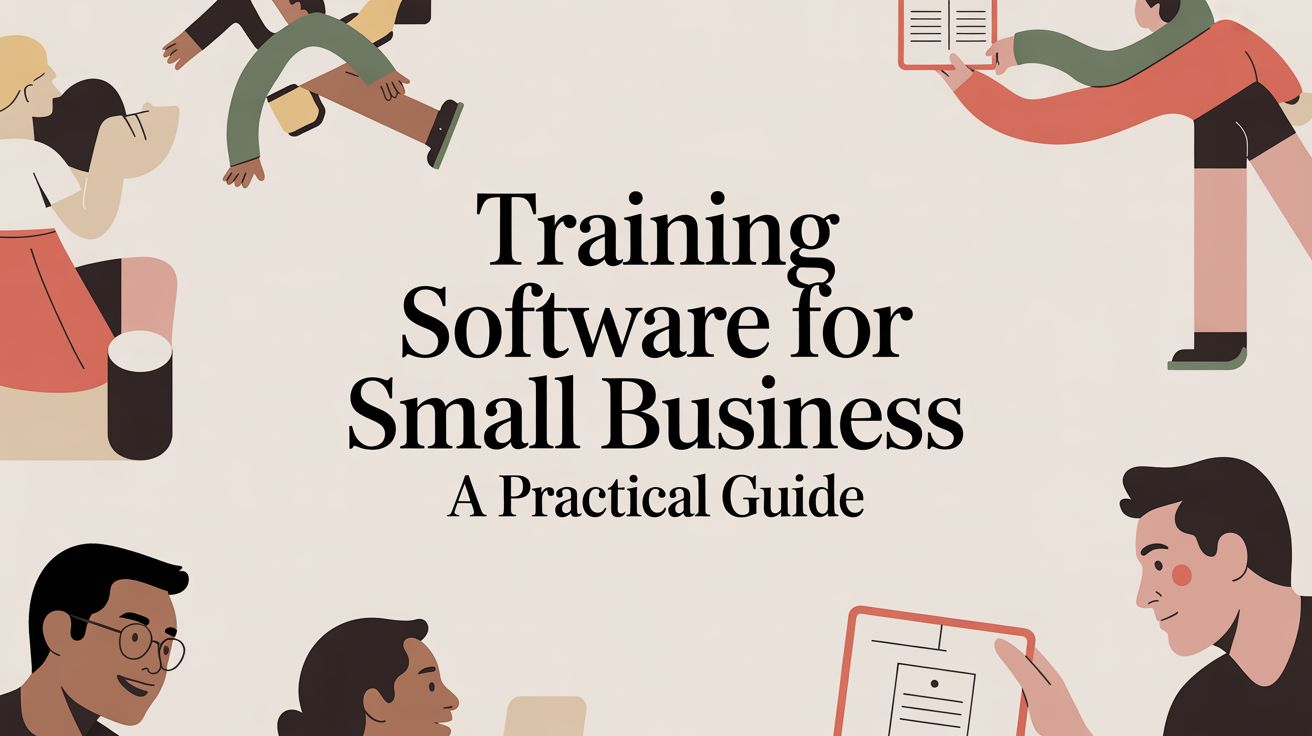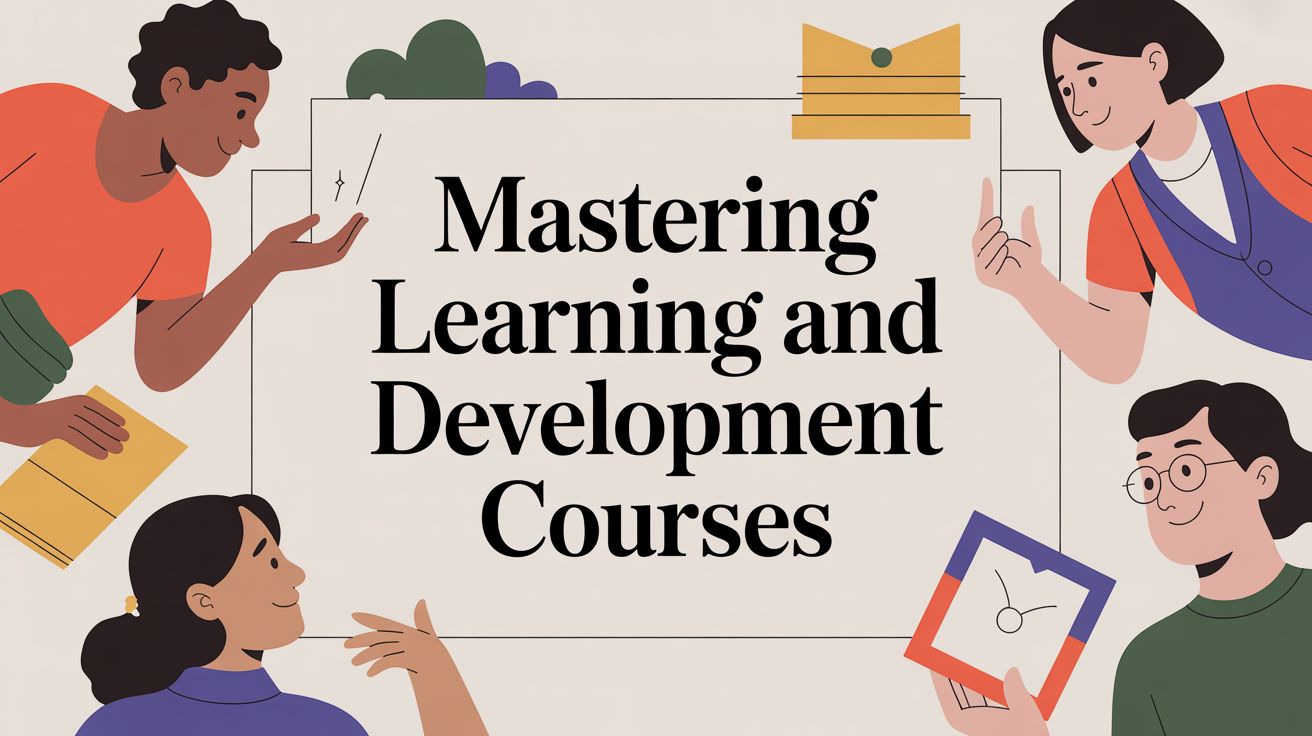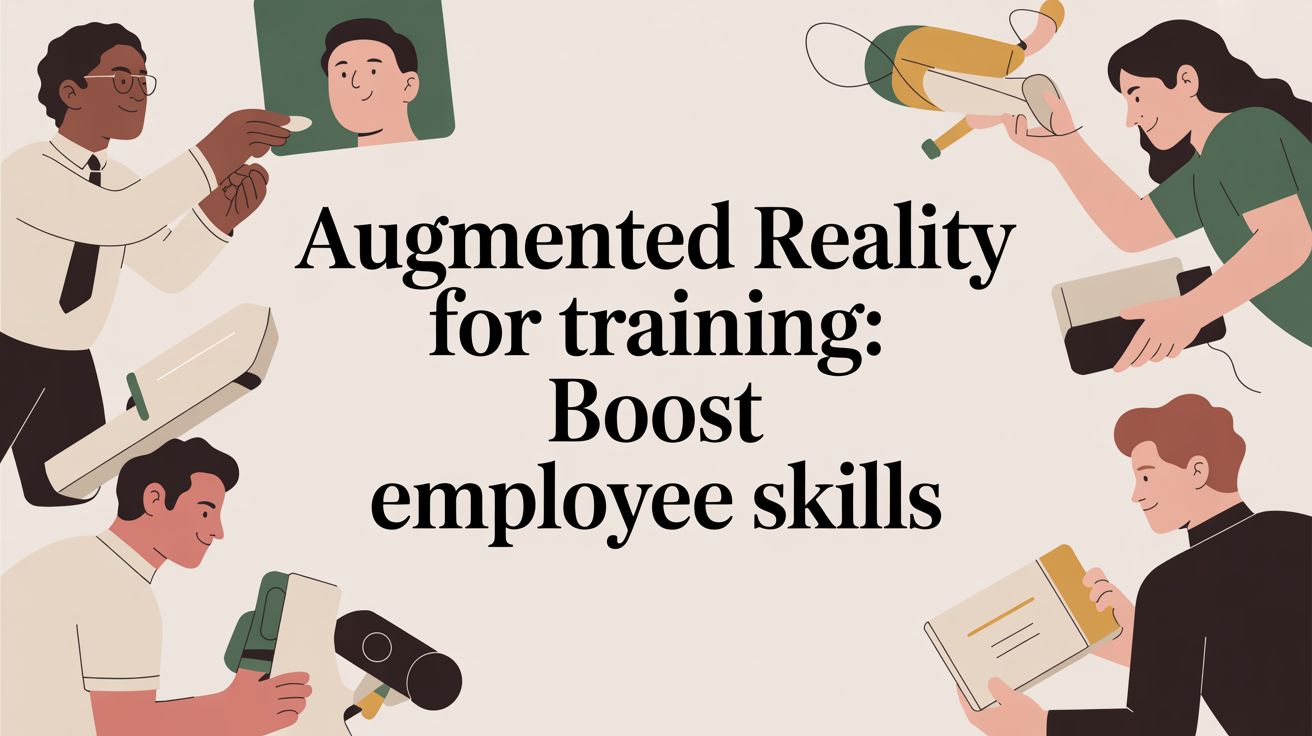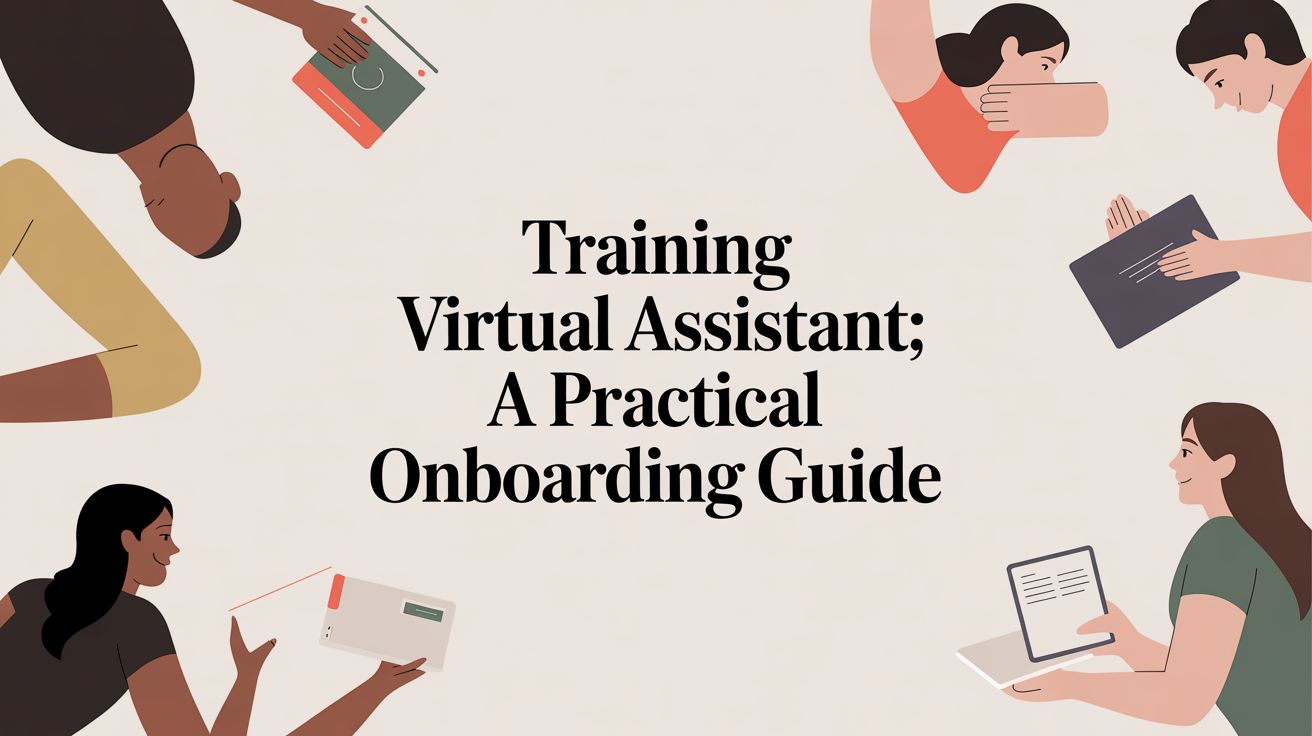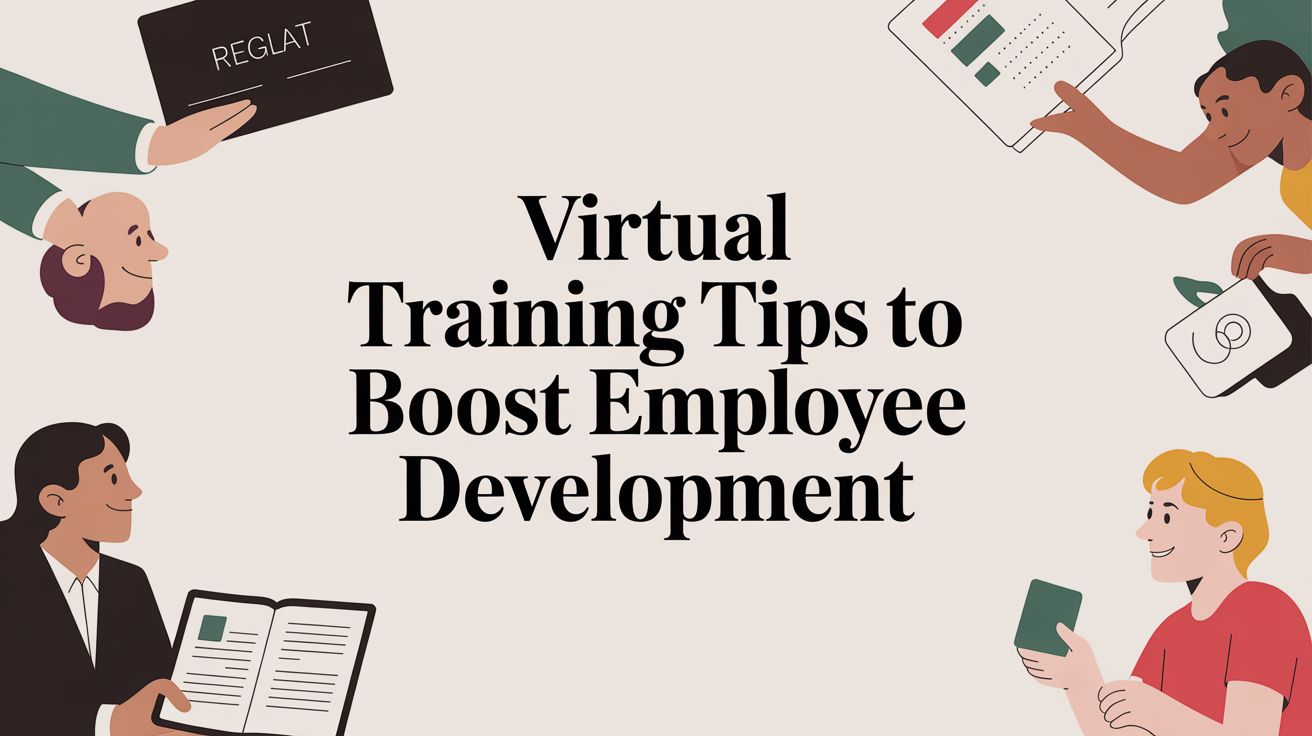What Is Interactive Training?

Interactive training is all about moving from passively listening to actively doing. It’s the difference between reading a book about how to swim and actually jumping in the pool. One gives you head knowledge, but the other builds a real, usable skill. You stop being a spectator and become a participant.
What Is Interactive Training, Really?
Let's cut through the jargon. For decades, a lot of training followed a simple, one-way street model: an instructor talks, and learners listen. Interactive training flips that script by creating a two-way conversation. It’s an approach built from the ground up on engagement, participation, and hands-on practice.
This is especially critical in live environments like instructor-led training (ILT) and virtual instructor-led training (VILT). In these settings, the goal isn't just to dump information on people; it's to make sure that information actually sticks. By weaving in activities, discussions, and real-time feedback, instructors can build a dynamic experience that keeps everyone focused and boosts understanding. The emphasis moves from just presenting content to guiding learners on a memorable, hands-on journey.
The Power of Active Participation
The whole idea behind interactive training is simple: people learn best by doing. When you ask learners to solve a problem, work together on a task, or run through a real-world simulation, their brains have to work harder and in different ways. This active involvement forges stronger neural pathways, making it much easier to remember and apply the knowledge later on.
It’s just flat-out more effective than sitting back and listening. Research shows that interactive and digital learning can drive knowledge retention up to between 25% and 60%. That’s a huge leap from the typical 8% to 10% retention rate you see in many traditional, lecture-based formats.
This infographic lays out the connection between the type of training and the results you can expect.
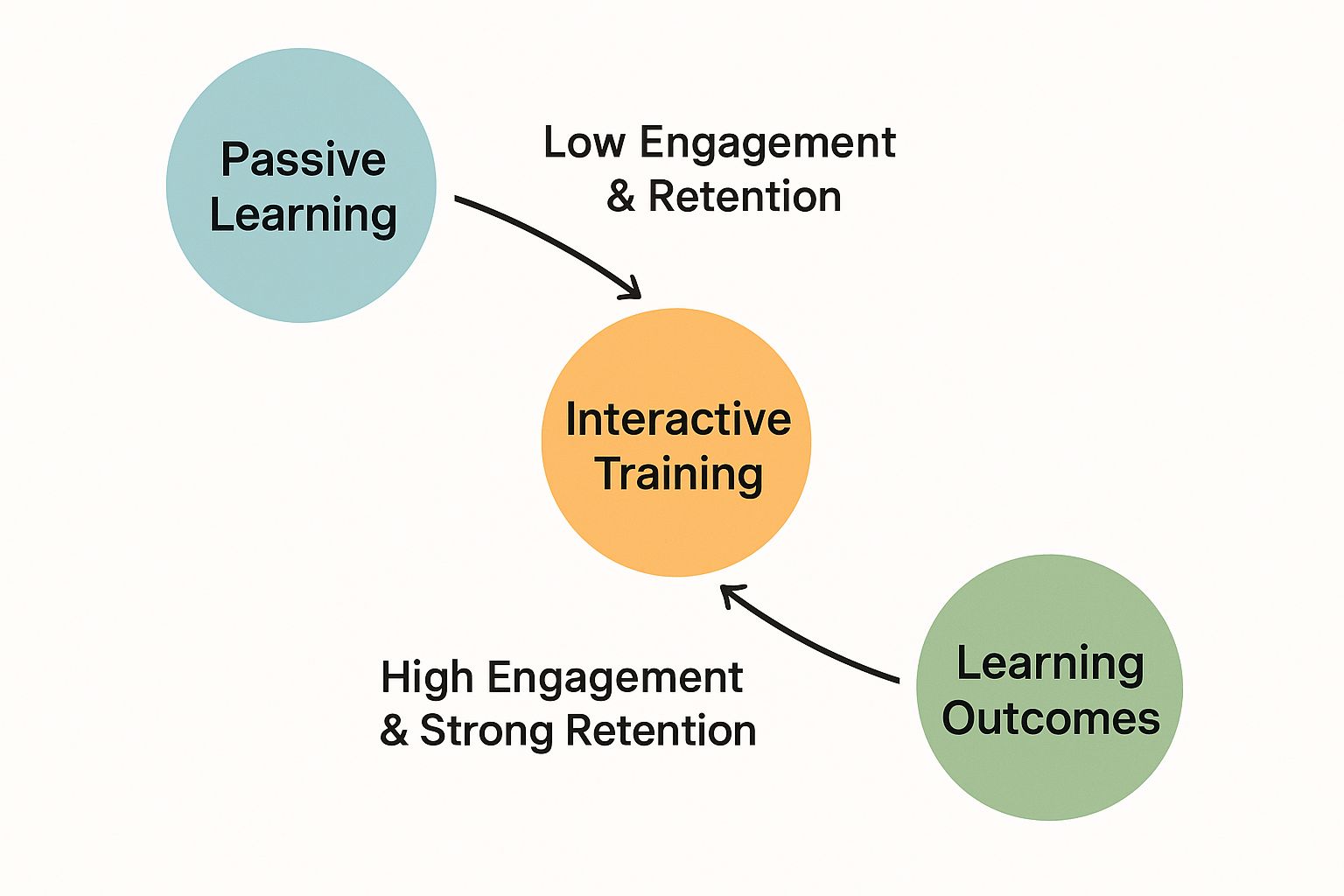
As you can see, passive learning often leads to a dead end of low engagement. Interactive methods, however, kickstart a powerful cycle where engagement and retention feed off each other. One of the best ways to do this is with dynamic media. For a closer look at one of the most effective tools in the modern training toolkit, check out this guide on What Is Interactive Video? A Guide to Better Corporate Training.
Making the Shift from Passive to Proactive
To really grasp the difference, it helps to see the two approaches side-by-side.
Passive vs Interactive Training At a Glance
This table breaks down the fundamental differences between the old-school lecture model and a modern, hands-on approach.
| Characteristic | Passive Training (Traditional) | Interactive Training (Modern) |
|---|---|---|
| Learner's Role | Spectator, recipient of information | Active participant, co-creator of knowledge |
| Flow of Information | One-way: instructor to learner | Two-way: dialogue and collaboration |
| Primary Activity | Listening, reading, watching | Doing, problem-solving, discussing, applying |
| Engagement Level | Low to moderate; easily distracted | High; requires focused attention |
| Knowledge Retention | Low (typically under 10%) | High (25% to 60% or more) |
| Learning Outcome | Theoretical knowledge, memorization | Practical skills, critical thinking, application |
| Instructor's Role | Lecturer, presenter | Facilitator, guide, coach |
The contrast is clear. One method is about consumption, while the other is about creation and application. It’s the difference between watching a cooking show and actually getting your hands dirty in the kitchen.
Key Insight: Interactive training isn’t just about making learning more "fun." It’s a deliberate strategy designed to make knowledge stick and skills practical, creating a direct line between the training session and what people do on the job.
By turning learners from passive attendees into active contributors, you can finally ensure that your training investment pays off with real-world skills and measurable business results.
Why Interactive Learning Drives Real Results
It's one thing to know what interactive training is, but the real question business leaders are asking is, "Why should we invest in it?" The answer comes down to the clear, measurable results that echo throughout an organization. When training shifts from a one-way lecture to a hands-on experience, it stops being a line-item expense and starts becoming a serious driver of performance and growth.

This isn’t just a passing trend; it's a major market shift. The global interactive training software market is on track to hit around $8 billion in 2025 and is projected to grow at a 15% Compound Annual Growth Rate (CAGR) through 2033. That kind of growth signals a widespread understanding that interactive methods just work better. For a deeper dive into these numbers, you can explore the full report from Archive Market Research.
It Dramatically Improves Knowledge Retention
Let's be honest: the human brain is wired to remember experiences, not just disconnected facts. Passive listening is like writing on a whiteboard—it’s there for a moment, then easily erased. Interactive training, on the other hand, is like carving that same information into stone. When learners have to actively solve a problem or practice a new skill, they're building much stronger, more durable neural pathways.
Think about a new support agent learning how to handle an upset customer. They can read a script, sure. But putting them in a role-playing scenario where they have to actually calm a frustrated (pretend) customer? That’s an entirely different ballgame. That experience creates a kind of muscle memory they can tap into under pressure, long after the training session is over.
It Boosts Learner Engagement and Focus
In a world of constant notifications and the dreaded "Zoom fatigue," just holding someone's attention is half the battle. Traditional, one-way presentations practically invite minds to wander. Interactive training, by its very design, demands focus.
The moment you introduce a live poll, a Q&A session, or a quick group chat, you pull people back into the room. They're no longer just passively consuming content; they're actively shaping the conversation. This simple shift turns a monotonous lecture into a lively dialogue, which is absolutely critical for keeping energy high, especially in virtual instructor-led training (VILT) settings.
Pro Tip: Keep your interactive activities short and sweet. A quick three-minute breakout session followed by a five-minute poll can do a lot more to keep people engaged than one long, 30-minute exercise.
It Develops Practical, Real-World Skills
Theory is important, but most corporate training is really about building practical skills employees can use on Monday morning. This is where interactive training truly excels. It creates a safe sandbox where people can practice, fail, and refine their abilities without any real-world consequences.
Imagine how this plays out for different teams:
- Leadership Teams: Can tackle complex case studies to sharpen their strategic decision-making and get comfortable navigating ambiguity.
- Sales Reps: Can use role-playing to practice handling objections, building the confidence they need to perfect their pitch.
- Technical Staff: Can use simulations to troubleshoot equipment failures, getting them ready for high-stakes situations without putting actual assets at risk.
It Fosters Better Team Collaboration
Finally, many of the best interactive methods naturally get people working together. When you put employees in breakout groups to solve a problem or ask them to collaborate on a project, you're doing more than just teaching a topic. You're building communication skills, strengthening professional relationships, and creating a sense of shared purpose.
This collaborative element is priceless. A team that learns together is simply better equipped to work together. They get to know each other's strengths, develop a common language for solving problems, and build the trust required to handle tough projects back on the job. The connections made during training directly translate into more cohesive and effective teamwork in the long run.
Your Toolkit for Designing Interactive Sessions
Knowing why interactive training works is one thing, but knowing how to actually do it is where the magic happens. The good news? You don't need to tear down your existing training and start from scratch. It’s all about strategically weaving in the right tools and methods to get people involved, make them curious, and turn learning into an active experience.
This toolkit is packed with proven, practical techniques that you can use whether you're in a conference room or leading a session online.
Think of these methods as different tools for different jobs. Each one helps turn a one-way lecture into a memorable conversation. The trick is picking the right one for what you want your learners to achieve.
Spark Friendly Competition with Gamification
Who doesn't love a little competition? Gamification is all about adding game-like elements to the learning process—think points, badges, and leaderboards. It taps into that natural human drive to achieve and compete, making even dry or complex topics feel more engaging and fun.
Imagine a sales team wrapping up a product training module. Instead of just ending the session, you throw in a pop quiz where the top scorer earns a "Product Guru" badge. Suddenly, people are leaning in, paying closer attention, and a buzz of excitement fills the room.
Foster Critical Thinking with Case Studies
Case studies are where theory gets real. These are detailed stories about a genuine problem or situation, and they're perfect for pushing learners beyond just memorizing facts. You're challenging them to apply what they've learned to a messy, real-world scenario.
For instance, instead of just talking at a leadership team about strategic frameworks, give them a case study about a company on the brink of a market disruption. Their job is to dig into the details, weigh the options, and map out a plan. This process sharpens their analytical and decision-making skills in a safe, practical way.
Pro Tip: The more relevant the case study, the better. Use examples from your own industry or that mirror challenges your team is actually facing. When people see themselves in the story, their investment in solving it goes way up.
Build Confidence with Role-Playing Scenarios
When it comes to developing people skills, role-playing is an absolute powerhouse. It's all about acting out scenarios that employees will likely face on the job, like dealing with a frustrated customer, negotiating a tricky contract, or delivering tough feedback.
This technique is so effective because it builds "muscle memory" for social interactions. It gives people a chance to practice their responses, get instant feedback, and build the confidence they need to handle those high-stakes conversations with poise. There are many ways to approach this, and exploring various Top Interactive Learning Strategies can give you fresh ideas.
Encourage Peer Learning with Breakout Groups
In a large training session, it’s easy for people to hide. But put them in a small breakout group of three to five, and suddenly, everyone has a voice. The environment feels more natural and way less intimidating.
This method is fantastic for brainstorming, collaborative problem-solving, or just letting a group chew on new information. After you've presented a key concept, send teams into breakout rooms to discuss their takeaways or tackle a specific question. This peer-to-peer connection reinforces learning and exposes everyone to fresh perspectives. Of course, managing these moving parts requires a solid platform. You can learn more about the different https://coursebricks.io/blog/types-of-course-management-systems that help orchestrate these dynamic sessions.
To help you decide which method to use and when, here’s a quick guide for matching the technique to your training goal.
Choosing the Right Interactive Method
| Learning Outcome | Recommended Interactive Method | Best For (Example) |
|---|---|---|
| Skill Practice | Role-Playing | A customer service team practicing de-escalation techniques. |
| Problem-Solving | Case Studies | A management team analyzing a business challenge to devise a strategy. |
| Collaboration | Breakout Groups | A project team brainstorming ideas for a new marketing campaign. |
| Engagement | Gamification | An onboarding group competing in a quiz about company history and values. |
| Quick Feedback | Live Polls & Q&A | An all-hands meeting to quickly gauge employee sentiment on a new policy. |
Matching the right tool to your objective is the secret to creating a session that not only engages but also delivers tangible results.
Gather Instant Feedback with Live Polls
Especially in a virtual setting, live polls and Q&A sessions are your best friends. They are simple but incredibly powerful tools for keeping your audience plugged in. They give you a real-time pulse check on how well people are understanding the material and can instantly turn passive listeners into active participants.
You can use a quick poll to:
- Assess knowledge: Kick off a session with a question to see what the group already knows.
- Check for understanding: After explaining a tricky concept, launch a poll to make sure you haven't lost anyone.
- Gather opinions: Ask for input on a strategy to make your audience feel heard and valued.
By mixing and matching these techniques, you can design a training experience that doesn't just hold people's attention—it drives real skill development and knowledge that actually sticks.
How Technology Is Pushing Interactive Training Forward
While things like gamification and role-playing exercises definitely make training more engaging, there's a new wave of technology that’s creating immersive learning experiences straight out of science fiction. These tools don't just ask learners to click a button or answer a question—they transport them into entirely new, simulated worlds where they can practice complex skills safely and effectively.
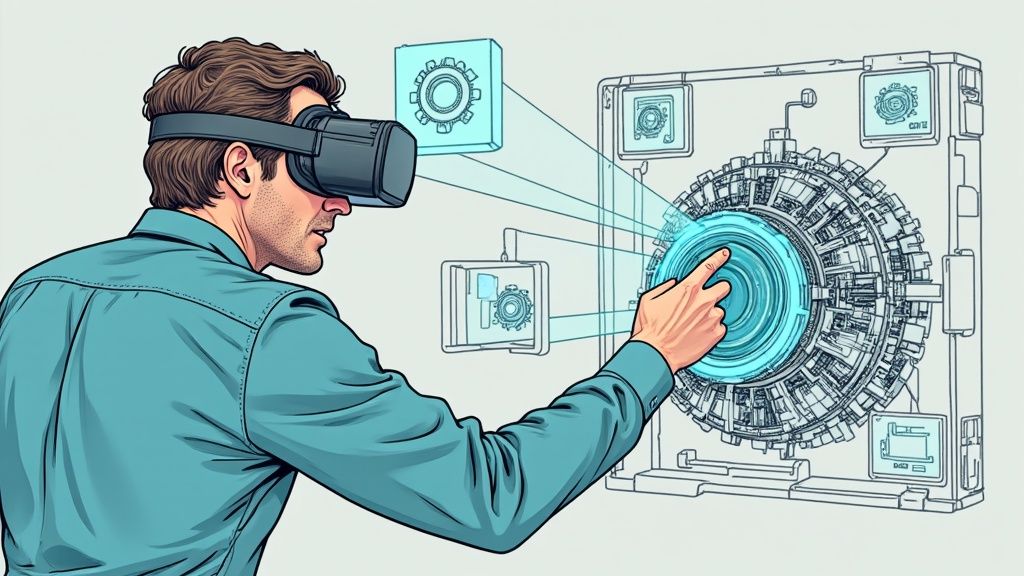
This isn't just about chasing the latest shiny object. It’s a practical solution for developing deep, hands-on skills in ways that a PowerPoint presentation simply can't. Instead of just talking about a high-stakes procedure, these technologies let employees actually live it.
Getting to Know Immersive Technologies
The world of immersive learning is really powered by three core technologies, which you'll often hear grouped together as Extended Reality (XR). Each one blends the digital and physical worlds in a unique way, opening up incredible possibilities for interactive training.
- Virtual Reality (VR): This is the one you’re probably most familiar with. VR completely shuts out the physical world and plunges the user into a simulated digital environment using a headset. It's perfect for practicing things that are too dangerous, expensive, or difficult to replicate in real life, like complex machinery operations or emergency safety protocols.
- Augmented Reality (AR): Instead of replacing your world, AR adds to it. It overlays digital information—like instructions, diagrams, or graphics—onto your view of the real world, usually through a smartphone or smart glasses. A great example is a technician pointing their tablet at an engine and seeing digital arrows pinpoint the exact part that needs repair.
- Mixed Reality (MR): MR is the most advanced of the three, taking AR a step further. It allows digital objects to not only appear in your world but to actually interact with it. Think of a medical student practicing a surgical procedure on a digital anatomical model that sits realistically on the training room table.
The growth in this field is exploding. The immersive training market was recently valued at around $16.4 billion, but it’s projected to rocket to nearly $69.6 billion by 2030. According to a market report from Grand View Research, that’s a compound annual growth rate of 28.3%, signaling a massive shift in how companies approach skill development.
From Learning the Steps to Building Muscle Memory
The real magic of these technologies is their ability to build genuine muscle memory. When an employee practices a complex shutdown sequence in a risk-free VR simulation, they aren't just memorizing steps from a manual—they are physically going through the motions. This creates a much deeper, more practical understanding that sticks.
Key Insight: Immersive technology transforms training from a purely mental exercise into a physical one. We learn best by doing, and these tools build skills through action, leading to better knowledge retention and faster competence on the job.
For any organization, this means a workforce that is better prepared, more confident, and far less likely to make critical, costly mistakes. Whether it's a pilot practicing emergency landings in a flight simulator or a retail associate learning a new store layout with an AR overlay, immersive training bridges the gap between knowing what to do and knowing how to do it.
While a solid Learning Management System is crucial for delivering asynchronous online courses, a dedicated Training Management System is what’s needed to schedule and manage the physical resources—like VR headsets or simulation rooms—for these kinds of live, immersive sessions. You can learn more about finding the best LMS for corporate training and how the two systems differ in our detailed guide.
Taming the Chaos of Interactive Training Management
Designing a brilliant interactive training session is a huge win, but it's really only half the battle. If you don't have a solid system to manage the behind-the-scenes chaos, even the best-laid plans can fall apart. This is where you need a strong operational backbone to organize, run, and scale your training programs, whether they're in-person, hybrid, or virtual.
This brings us to a crucial distinction between learning platforms. Most people are familiar with a Learning Management System (LMS), which is great for self-paced, asynchronous e-learning. But for the dynamic, real-time world of live, interactive training, you need something different: a Training Management System (TMS). A system like Coursebricks is built specifically for these complex logistics, acting as the command center for your entire instructor-led training operation.
Orchestrating All the Moving Parts
Think about what it takes to run a truly modern interactive session. You might have in-person attendees in breakout rooms, remote team members joining from a dozen different locations, and even specialized equipment like VR headsets for a hands-on simulation. Juggling all of that requires Swiss-watch precision.
A TMS is designed to bring order to that complexity. It gets you out of the messy world of scattered spreadsheets and endless email threads by giving you a single source of truth for everything.
Just look at this dashboard from Coursebricks. It pulls everything—courses, schedules, participants—into one clean, centralized view.
From here, an administrator can see everything from course creation all the way through to financial tracking, giving them total control over the program's logistics.
The Big Idea: A good TMS doesn't just manage schedules; it orchestrates the entire learning experience. By automating the logistical headaches, you free up your trainers to focus on what they do best: delivering fantastic, high-impact training.
Streamlining How You Handle Schedules and Resources
One of the biggest headaches in running live training is just managing all the resources. We're talking about everything from physical rooms and equipment to your most valuable asset: your people. A TMS automates this whole process, making sure everything and everyone is where they need to be, right on time.
With a system like Coursebricks, you can finally stop the frantic last-minute scrambling. It lets you:
- Book and assign physical rooms for your in-person sessions without worrying about double-bookings.
- Allocate specialized equipment like VR headsets, lab kits, or specific software licenses to the right session.
- Schedule instructors and facilitators based on their real-time availability and expertise, which means no more scheduling conflicts.
- Manage registrations and track attendance seamlessly, whether people are showing up in person or logging in from home.
This kind of organization is what allows you to grow. As your programs get bigger and more complex, trying to manage them manually just isn't sustainable. A TMS provides the framework you need to scale up without your quality taking a nosedive. To see how these features can fit different needs, you can check out the Coursebricks pricing and feature tiers.
Using Feedback to Get Better and Better
The best training programs are never "done." They're constantly evolving based on what you learn from your participants. A TMS with built-in communication tools makes gathering that feedback incredibly simple.
Once a session wraps up, you can automatically send out post-training surveys. Ask the important questions. Did the breakout groups feel productive? Was the role-playing scenario realistic and helpful? Did anyone struggle with the technology?
The answers to these questions are pure gold. By analyzing this feedback, you can quickly see what’s working and what isn't, allowing you to fine-tune your approach and make sure every training you deliver is even better than the last.
What's Your Next Move for More Engaging Training?
We've covered a lot of ground, and if there's one thing to take away, it's this: interactive training isn't just a "nice-to-have" anymore. It's the core of what makes learning and development stick. We’ve looked at why it’s so powerful for boosting retention and how to actually pull it off with real-world methods. Making that shift from passive listening to active doing is how you build skills that last.
The most important thing? Start small, but start now. You don’t need to tear down your entire training program and rebuild it from scratch overnight.
Build Momentum, One Step at a Time
Instead of getting overwhelmed by a massive overhaul, just pick one simple interactive element to add to your very next training session. It could be as easy as starting with a live poll to get everyone warmed up or breaking the group into five-minute discussion rooms to chew on a key idea. The goal here is to get the ball rolling and see for yourself how much it changes the energy in the room.
Once you’ve got one thing down, try adding another. This gradual, step-by-step process makes the transition feel natural for you and your learners, slowly building a more interactive culture.
Key Takeaway: The road to dynamic training isn't a giant leap. It's a series of small, deliberate steps. Just focus on making your next session 10% more interactive than the last one.
The Right System to Help You Grow
As you start adding more and more interactive elements, you'll quickly realize that trying to manage everything manually is a headache. This is where a proper training management system becomes your best friend. It provides the structure you need to organize, manage, and scale your programs without losing your mind.
While a typical LMS is built for self-paced eLearning, a system like Coursebricks is designed specifically for the moving parts of live, instructor-led training. It handles all the operational heavy lifting—scheduling, resource management, and communication—so you can focus on what you do best: creating incredible learning experiences.
Ready to see how the right system can make your shift to dynamic training a whole lot smoother? You can explore all the features and see the difference for yourself by starting a free Coursebricks trial.
Got Questions? We've Got Answers
As you start thinking about bringing more dynamic, hands-on methods into your training programs, a few questions tend to pop up. Let's tackle some of the most common ones to clear up how interactive training works in the real world.
What's the Real Difference Between Interactive Training and E-Learning?
This one really boils down to two things: timing and participation.
Think of e-learning as the on-demand, self-serve option. A learner logs into a Learning Management System (LMS), watches some videos, and takes a quiz whenever they have a free moment. It’s a solo, asynchronous activity with no live instructor or real-time group collaboration.
Interactive training, on the other hand, is all about the live event, whether it's happening in-person, virtually, or in a hybrid format. The whole point is real-time participation, a back-and-forth dialogue with a facilitator, and collaborative exercises like breakout sessions or role-playing. E-learning is about consuming content; interactive training is about creating understanding through action.
Can This Interactive Stuff Actually Work for Dry Topics Like Compliance?
Yes, and honestly, it’s often the only way to make dense, mandatory topics stick. We've all sat through those compliance sessions where we just passively read policy documents. How much of that do we actually remember a week later?
Interactive techniques take abstract rules and make them real. For instance:
- Ethics Training: Instead of just listing company policies, you could run a role-playing scenario where employees have to navigate a tricky ethical grey area. This forces them to think critically and apply the rules in a situation that feels real.
- Safety Procedures: Rather than just showing a diagram, get people to walk through a safety protocol using a simulation or a hands-on exercise. That kind of practice builds muscle memory in a way reading a manual never could.
The Big Idea: Interactivity turns compliance training from a "check-the-box" chore into something genuinely memorable. When you put learners into realistic situations, they finally grasp the "why" behind the rules and build the confidence to act on them.
How Do I Even Measure If Interactive Training is Working?
Measuring success here means looking past simple attendance sheets. Knowing who showed up is one thing, but the real goal is to see if anything actually changed. A much stronger approach is to track metrics that show a genuine shift in skills and on-the-job performance.
You can get a much clearer picture of your impact by focusing on a few key areas:
- Skill Assessments: Use pre- and post-training assessments to get a hard measurement of knowledge gain. Can you see a clear improvement in skill levels after the session?
- On-the-Job Performance: Look for concrete changes in work-related numbers. After a sales training, for example, did conversion rates tick up? Following a customer service workshop, did negative feedback tickets go down?
- Direct Feedback: Use post-training surveys to ask targeted questions about the experience itself. Ask participants to rate how engaging the session was and which specific activities helped them learn the most.
When you blend these hard numbers with qualitative feedback, you can confidently show that your interactive training isn't just a fun activity—it's delivering real, measurable business results.
Ready to explore Coursebricks?
Manage training programs, automate emails, and generate detailed reports — all in one place.






